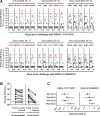Detection of post-vaccination enhanced dengue virus infection in macaques: An improved model for early assessment of dengue vaccines
- PMID: 31009499
- PMCID: PMC6497418
- DOI: 10.1371/journal.ppat.1007721
Detection of post-vaccination enhanced dengue virus infection in macaques: An improved model for early assessment of dengue vaccines
Abstract
The need for improved dengue vaccines remains since the only licensed vaccine, Dengvaxia, shows variable efficacy depending on the infecting dengue virus (DENV) type, and increases the risk of hospitalization for severe dengue in children not exposed to DENV before vaccination. Here, we developed a tetravalent dengue purified and inactivated vaccine (DPIV) candidate and characterized, in rhesus macaques, its immunogenicity and efficacy to control DENV infection by analyzing, after challenge, both viral replication and changes in biological markers associated with dengue in humans. Although DPIV elicited cross-type and long-lasting DENV-neutralizing antibody responses, it failed to control DENV infection. Increased levels of viremia/RNAemia (correlating with serum capacity at enhancing DENV infection in vitro), AST, IL-10, IL-18 and IFN-γ, and decreased levels of IL-12 were detected in some vaccinated compared to non-vaccinated monkeys, indicating the vaccination may have triggered antibody-dependent enhancement of DENV infection. The dengue macaque model has been considered imperfect due to the lack of DENV-associated clinical signs. However, here we show that post-vaccination enhanced DENV infection can be detected in this model when integrating several parameters, including characterization of DENV-enhancing antibodies, viremia/RNAemia, and biomarkers relevant to dengue in humans. This improved dengue macaque model may be crucial for early assessment of efficacy and safety of future dengue vaccines.
Conflict of interest statement
The authors declare the following conflicts: MAC, OT, SB, KS-O, YV, CL and LW are employees of the GSK group of companies. DWV used to be an employee of the GSK group of companies at the time when the study was performed. M-PM worked under contract with GSK at the time when the study was performed. KS-O, DWV, YV, CL and LW report owning shares and/or restricted shares in the GSK group of companies. MBB, RSM, RCP, YDSM, LGAM, LD-M, MF, AH and EC are employees of Fiocruz which was contracted by GSK in the context of this study.
Figures





Similar articles
-
Improvement of the Dengue Virus (DENV) Nonhuman Primate Model via a Reverse Translational Approach Based on Dengue Vaccine Clinical Efficacy Data against DENV-2 and -4.J Virol. 2018 May 29;92(12):e00440-18. doi: 10.1128/JVI.00440-18. Print 2018 Jun 15. J Virol. 2018. PMID: 29593041 Free PMC article.
-
An adjuvanted, tetravalent dengue virus purified inactivated vaccine candidate induces long-lasting and protective antibody responses against dengue challenge in rhesus macaques.Am J Trop Med Hyg. 2015 Apr;92(4):698-708. doi: 10.4269/ajtmh.14-0268. Epub 2015 Feb 2. Am J Trop Med Hyg. 2015. PMID: 25646261 Free PMC article.
-
The immunogenicity of tetravalent dengue DNA vaccine in mice pre-exposed to Japanese encephalitis or Dengue virus antigens.Asian Pac J Allergy Immunol. 2015 Sep;33(3):182-8. doi: 10.12932/AP0508.33.3.2015. Asian Pac J Allergy Immunol. 2015. PMID: 26342114
-
Does structurally-mature dengue virion matter in vaccine preparation in post-Dengvaxia era?Hum Vaccin Immunother. 2019;15(10):2328-2336. doi: 10.1080/21645515.2019.1643676. Epub 2019 Aug 23. Hum Vaccin Immunother. 2019. PMID: 31314657 Free PMC article. Review.
-
Dengue Vaccines: The Promise and Pitfalls of Antibody-Mediated Protection.Cell Host Microbe. 2021 Jan 13;29(1):13-22. doi: 10.1016/j.chom.2020.12.011. Cell Host Microbe. 2021. PMID: 33444553 Review.
Cited by
-
Anti-dengue Vaccines: From Development to Clinical Trials.Front Immunol. 2020 Jun 18;11:1252. doi: 10.3389/fimmu.2020.01252. eCollection 2020. Front Immunol. 2020. PMID: 32655561 Free PMC article. Review.
-
Challenges on the development of a dengue vaccine: a comprehensive review of the state of the art.J Gen Virol. 2023 Mar;104(3):001831. doi: 10.1099/jgv.0.001831. J Gen Virol. 2023. PMID: 36857199 Free PMC article. Review.
-
Temporal patterns of functional anti-dengue antibodies in dengue infected individuals with different disease outcome or infection history.Sci Rep. 2022 Oct 25;12(1):17863. doi: 10.1038/s41598-022-21722-2. Sci Rep. 2022. PMID: 36284116 Free PMC article.
-
Enhanced dengue vaccine virus replication and neutralizing antibody responses in immune primed rhesus macaques.NPJ Vaccines. 2021 May 21;6(1):77. doi: 10.1038/s41541-021-00339-y. NPJ Vaccines. 2021. PMID: 34021159 Free PMC article.
-
Mammalian animal models for dengue virus infection: a recent overview.Arch Virol. 2022 Jan;167(1):31-44. doi: 10.1007/s00705-021-05298-2. Epub 2021 Nov 10. Arch Virol. 2022. PMID: 34761286 Free PMC article. Review.
References
-
- Halstead SB. Dengue Antibody-Dependent Enhancement: Knowns and Unknowns. Microbiol Spectr. 2014; 2. - PubMed
Publication types
MeSH terms
Substances
LinkOut - more resources
Full Text Sources
Medical
Miscellaneous

